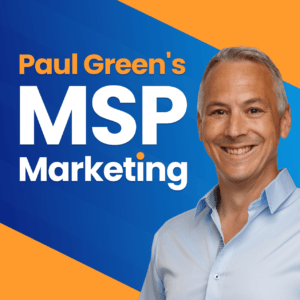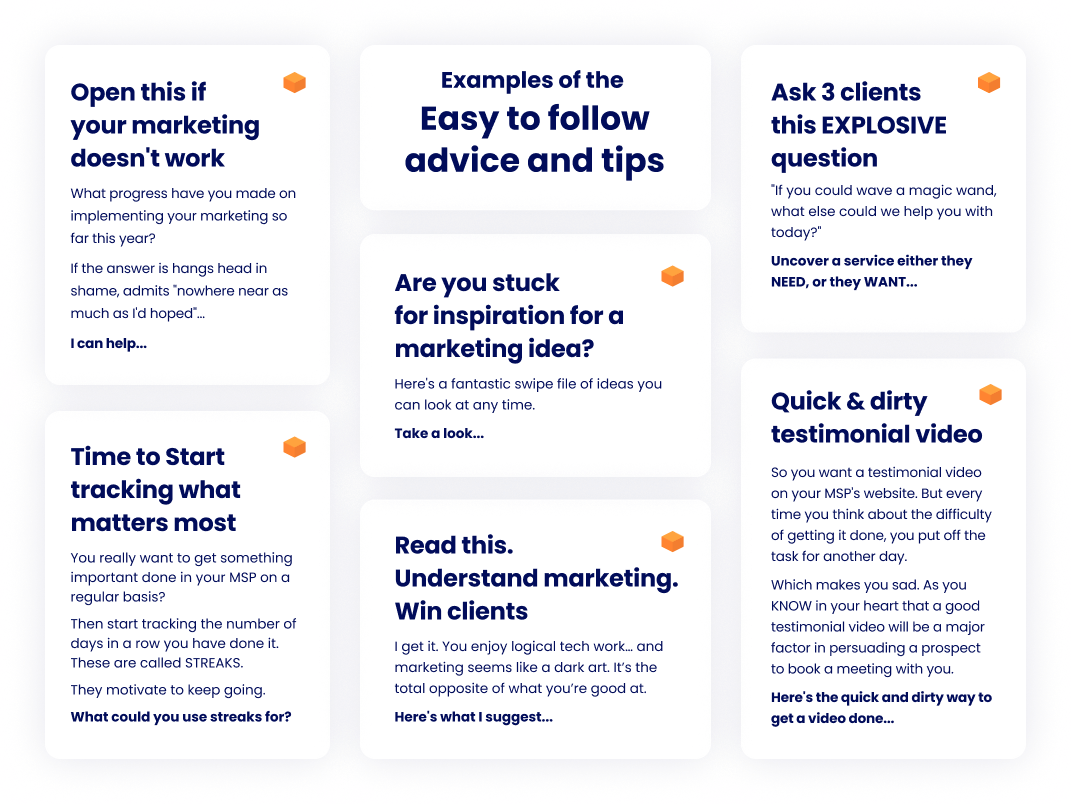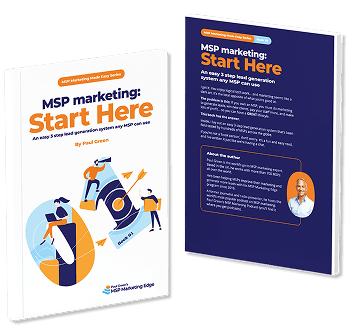
The podcast powered by the MSP Marketing Edge
Welcome to Episode 292 of the MSP Marketing Podcast with me, Paul Green. This week…
- Does your service desk manager really need to be a tech?: A service desk manager’s job is to make sure your MSP’s clients are delighted while freeing you up to grow the business. It’s possible that the best person for this job isn’t a technician.
- How your MSP can break into a new vertical: It’s easier to do marketing, find new clients, and make more money for your MSP, if you choose a vertical. Here’s how to get started.
- The framework MSPs can use to be more efficient: Visionary leaders are notorious for moving at such speed that they leave a trail of chaos behind them. My guest helps such visionaries put an end to operational chaos and create operational excellence in their business.
- Paul’s Personal Peer Group: Have you considered how your MSP would respond to a supply chain attack and what marketing actions you would take? If not, it would be a very wise idea.
Does your service desk manager really need to be a tech?
You may just have to tear up that job ad, and let me tell you why. We all know a service desk manager is a critical role. It’s their job to make sure the clients are delighted while freeing you up to grow the business. But whoever said that a service desk manager has to be a tech. What if there’s a different kind of person who’s much more suited to this kind of role?
I really do talk to a lot of MSPs. In fact, it’s one of the most wonderful things about the work I do. I get to talk to lots of different people about lots of different things. And because of my work in my MSP Marketing Edge where we are working with 700 MSPs, I talk to people in all sorts of different circumstances. So we have startups, two businesses that have been going for 30 years. We’ve got one person bands, two businesses with 200 employees. We’ve got all of these and everything in between.
But there’s one thing that I notice again and again and again, and that’s that the most successful MSPs, and let’s define successful as, the owner can do what they want to do with their life. They’ve got enough cash and they’ve got enough time, that’s success is to have that.
The MSPs who are most successful are those where the owner is surrounded by a very good team who take on the burden of the work for them.
Because it’s just too difficult to do everything yourself for more than a couple of years. What’s acceptable for our first few years in business gets tiring and boring as time goes on. And I’m sorry if that’s disappointing news for you because you never wanted to have staff, but it is the difference between just working for yourself and having a business that can survive and thrive without you.
And of course, one of the most key hires in there is a service desk manager or change that job title to whatever is appropriate for you. But basically someone whose entire role is to keep the clients happy and make sure that the work happens as it’s supposed to. Now, different MSPs have different ways of doing this, but they all come down to the same things. You’ve got some technical resource and you’ve got customers who want things to be done, and the service desk manager sits in the middle of that making the magic happen. If you own the business and you are currently doing that as well as the marketing and the sales and looking after the team and account management and finance and admin, that’s so tiring. What a liberating role to have a service desk manager whose entire working existence is focused on the clients and managing resources.
For some people, that’s their dream job. But let me challenge you on exactly who should be doing that job. You see, I’ve always believed and in fact operated this way, that it’s better to hire people who have a great mindset and then train them with the skills that they need to do a specific job. Back when I was working in radio in the early noughties, I had two radio presenters working for me who were either end of this scale. So Kev was naturally talented, but he had a terrible mindset and he was lazy, whereas Tom was less naturally talented, but worked very, very hard to make up for it. Now, guess which of those two was a pleasure to work with and went on to have a very successful career. And guess which one was such a pain in the backside that I took immense pleasure in firing him one day. He’s still in radio, but only just hanging on compared to the other guy.

So if you go with that, mindset first then upskill them, let me ask you a question. Should you necessarily hire a technician to be your service desk manager or should you hire a normal person and then just teach them a few technical skills that they need? Because what are the other skills that the service desk manager needs, right? Well, they need to be great communicators. They need to have the ability to plan and manage resources. They’ve got to be flexible and able to respond to problems quickly. And of course they have to be good with people and to help a team to work efficiently. That means building trust, it means keeping a team motivated, and I’m sure there are other requirements that I haven’t yet thought about.
Here’s the thing. There are people out there who have the mindset to thrive under those exact circumstances. Maybe right now they’re in other sectors, they’re not necessarily even working in technology. But really what technology skills does a service manager need? Does the service manager actually need to know how to configure a server? Do they really need to know how to talk to the third line technician who’s going to do it? Or can a normal person who has spent a career somewhere else keeping clients happy and managing resources, could they do the same for your MSP? What do you think about this? Is hiring a normal person instead of a tech to be your service desk manager, is that an interesting idea to you, or do you think I’ve completely lost the plot?
There’s a certain type of MSP where everything’s easier.
It’s easier to make more money, find new clients, and do the marketing that’s going to find you those clients and get all of that money into your business.
In fact, you may have heard that it’s the MSP’s targeting verticals that are enjoying this easy life, but how exactly do they do it?
Let’s find out how your MSP can break into a new vertical and why it’s going to make everything so much easier.
There are many benefits of marketing to a vertical. You can do it alongside your general business if you want to.
And once you’ve picked a vertical, there are a number of actions that you should take to get your marketing properly set up. Here are the first nine that I recommend in the order that you should do them.
Number one, build a website just for that vertical. The easy thing is just to put a page on your existing site, but don’t do that. If you’re going to do this and go for a vertical, really go for it properly. And that means a second website. Put together a proper four to five page website because the goal is to appear to be a true specialist to your target prospects. And a proper website is a basic MSP marketing fundamental. Also, the process of you going through creating that new website, it kind of imprints inside you at your very core that this is a big direction you’re going in and you’re going to take the whole marketing journey so much more seriously.
Number two, set up a vertical specific LinkedIn or Facebook or Instagram, depending which platform most decision makers in that vertical use. So for example, in hospitality and retail you would use Instagram, for B2B you would use LinkedIn, but again, have a separate one to your regular one. You can have your general LinkedIn, that’s just for your general business. And then you can have a vertical specific LinkedIn that’s just for your vertical business. And it means that in your vertical business, you are only connecting to people who are in that vertical. It allows your marketing to be targeted on LinkedIn very, very easily.
Number three, start posting regular content so you have a presence. Make sure to edit your content slightly to put the name of the vertical into the headline or the paragraph, like the intro paragraph. Sometimes making content seem relevant to a vertical is as simple as just mentioning that vertical. So you might say, Here’s how technology can improve productivity for accountants (CPAs). But also look at how they refer to themselves and their businesses. So to take CPAs as an example, they don’t have a business, they have a “practice”.
Number four, start networking within that vertical and meeting as many decision makers as you can. Look for relevant vertical business shows or other events that you can attend because nothing but nothing beats pressing the flesh when you’re just getting started in a new vertical, or in fact, in any new market. You’ll have a marketing revelation at every event, I promise you.
Number five, build your email list. It’s so easy to get started with a vertical, you can just buy targeted data or scrape targeted data or just go onto Google, type in the vertical you want to reach and the geographic area where they are and there’s everyone that you want to possibly reach.
Number six, get your marketing machine working, generating prospects that you can speak to and then call them. Once you’ve got someone into your audiences and you are growing a relationship with them, you always want to pick up the phone and just call them and speak to them. Phone calls will get you where you want to go faster, I promise you. And I know you don’t like picking up the phone, you don’t like making outbound calls, but these don’t have to be sales calls, they can be relationship building calls, they can just be research calls. Tell me about your business. How’s everything going? What’s holding you back right now? You could almost say to them, Hey, we’ve just started working with vertical businesses. I’m just doing some market research, do you mind if I ask you a few questions? They won’t hold that against you if a year or two down the line they’re genuinely seriously looking at using you as their MSP.

Number seven, once you have your first vertical client, and actually the easy way to pick a vertical is to take a client that you’re already working with. Let’s say you’re already working with a dentist and go and look for more dentists, but that’s by-the-by. Once you have one vertical client, work hard to delight them then turn them into a case study or a testimonial as quickly as you can, because this gives others the faith to buy from you. When someone’s working with a vertical specialist, they expect to see reviews, testimonials, and case studies from other people in their vertical.
Number eight, look for other forums where your vertical decision makers hang out. Do they have Facebook groups, LinkedIn groups or chat forums? Can you become a member of these groups? And it’s best to do this properly and above board rather than trying to sneak in. Don’t sell, never sell in these things, add value by answering relevant questions and make sure that there is a link to your website in your profile.
And then number nine, get to know the movers and shakers in the vertical associations. Ultimately, you and the associations and any kind of groups, you’re all serving the same people in that vertical. So be persistent getting to know them, but do play a long game. You’ve got to build trust with them before you can attend their events and get involved in their organisation. The key question to ask is what do they want or need and how can you help them to get it? It’s almost a universal law that, if you help someone else they will help you.
The framework MSPs can use to be more efficient

Featured guest: Emma Rainville is the owner of Shockwave Solutions and co-founder of multiple operationally focused brands. She turns chaos into clarity for fast-growing entrepreneurs, especially in direct response and e-commerce.
Emma has scaled brands to 8- and 9-figures, engineered operations that run lean and fast, and built teams that actually execute.
Emma is also the author of SCOPE: An Operational Framework for Proven Reality Execution, a blueprint used by founders and COOs to finally get control of their businesses and teams.
When not behind the curtain tightening systems, Emma is on stage showing founders how to scale with precision and peace of mind. They call her the Wizard of Ops for a reason.
So you have big things you want to do with your MSP, and that’s great until you start to implement. Because as any business owner knows few plans work out exactly how you thought they would on day one, and no more so than in operations especially in fast-growing MSPs.
My special guest today is an expert at helping ambitious business owners like you leverage AI to make operations so much more efficient.
Hi, I’m Emma Rainville, and I have been dubbed the Wizard of Ops. I help visionary entrepreneurs end operational chaos and create operational excellence in their business through streamlined operations.
Amazing. And you definitely win the best podcast title of the year, the Wizard of Ops. Who was it who gave you that title?
Perry Belcher. So of course the godfather of marketing gave me the title, so obviously I win.
Yeah, absolutely, you’ve won like times thousand, and the vast majority of MSPs listening to this or watching this on YouTube may not have heard of Perry Belcher, but for a marketing fanboy like me, it’s like, oh, wow. I mean, Perry Belcher is just one of the big names of marketing, of small business marketing. He’s been around for about 20 years and I’ve given him a few thousand over the years for various courses and things. Everyone wins because Perry stuff is really good.
So explain to us what being the Wizard of Ops mean, and you said obviously you help entrepreneurs with their operations. What do you actually do? What’s your day-to-day life like?
Sure, so my company is called Shockwave Solutions, and we’re a fractional COO services company. And what makes us unique is that we come with an execution team. So you don’t just get a COO that’s going to give you a bunch of great ideas and then you have no way to plug them in. We come with a team that’s actually going to plug them in and get you results. And so what we do is we come in and we specifically work with visionary entrepreneurs. Visionary entrepreneurs are a different animal all of their own. They need to be managed and nurtured while plugging in their vision because they have big, big, big dreams and goals, and they just need streamlined operations to get them to where they’re trying to go.
So when you talk about working with visionary leaders, are we talking about the kind of person that is moving at such speed towards this amazing future that they leave this trail of chaos behind them?
Absolutely. That’s exactly what happens. And then as soon as they’re done relaying that vision, they’ve already thought of the next thing they’re going to do. And before anyone can plug anything in, they run back into the room and throw wrenches at the entire team who’s trying to build the first thing. So they’re generally frustrated with the fact that their whole team can’t keep up with them.
Yeah, that makes perfect sense. And I think even if you would consider yourself not to be a visionary entrepreneur, I think every business owner on the planet can hear what you’ve just said there and think, yeah, whether I’ve done it deliberately or not, I’ve done some level of that to my team. I know I have, and I know a lot of the MSPs that I work with have. And I think partly that comes from the fact that as the business owner, we decide we want to do something and then we sit for days or weeks or months thinking about it, planning it, talking about it, fleshing it out in our brain, and then one random Wednesday afternoon, we’ll call everyone together onto a Zoom or a Teams call and we’ll say to them, Hey, guess what, we’re going to do this amazing thing, which is A, B, C, and that’s going to cause X, Y, Z to happen and blah, blah, blah. It’s brilliant. Let’s go. And what has taken weeks to ferment in our brain and become fully firmed in our brain, we’ve just dumped on our team with 10 seconds notice, and then we wonder, why don’t they get that? Why isn’t everyone running around?
Also, it hasn’t been fully formed, you have the big picture and not the details. So you believe that you’ve relayed this beautiful map of excellence to exactly where you want to go with simple, streamlined plugin. And what you’ve really created was a whole bunch of questions that you have no tolerance to sit and answer.
I love that. My team are going to be listening to this podcast nodding their heads going, Yeah, we understand that completely. So it’s almost like you guys then are the support for the survivors group that’s left behind.
It’s a great way of putting it, I call it integrator. But we basically take the vision and we strategically plan it, and then we integrate it into the business at the appropriate time.
How do you do that? And I’m not asking you to give away the secret sauce or your business but how does anybody plan that kind of implementation around that speed and that urgency of changing things and getting things done?
Sure, so it’s two methods. The first one is having a foundational framework, and that’s called WAVE: Written vision, Absolute focus, Values driven future and Execution plan. So where are we actually trying to go in 1, 3, 5, and 10 years? I need to understand very intricately what you want the business to look like. It doesn’t have to be specifics, but what does the business look like, what are we trying to build? The number two thing is what am I absolutely focused on? When you come up with a hundred great ideas, what am I focused on? What is the business’s purpose? What is the problem that we solve? Values driven future, what are our values in the business? What’s important to us? And then execution plan is how do we execute and continue to move forward? So what that means is what is our meeting cadence? What is our communication channels? How do we set goals and how do we change things? When is it okay, and when is it not okay? When you have a plan ahead of time that allows you to set boundaries and rules around it, it makes everything a lot easier.
When everybody on the team knows where we’re trying to go and what we’re trying to do, they’re able to fill in a lot of the blanks themselves.
And then the second thing is an operational framework. So we have the foundational framework, then we have the operational framework, and that’s the one that’s going to direct our business on the day to day. So that’s called SCOPE, and that’s what my book is called. So S is setting your vision. S is actually WAVE, so setting your vision. C is creating processes, making sure we have all of our processes documented, understood, profitable and efficient. O is operational excellence, always functioning in a way that is operationally excellent. That means from the sales process to delivery process to the day-to day of our business, things are running in a way that makes our customer base or our client base happy. P is people development, can’t grow your business without growing your people. That’s a mistake so many people make. And then the E again is execution. How are we going to execute all of this? So when a big great idea comes into play, that fits our absolute focus, at what point do we insert that in the business so we don’t burn everything else down that we’ve planned? And when you have those boundaries, those guidelines, those rules and that roadmap, you’ll go from a great idea to a great business, to great revenue, to really great profits.
I love that, and the business owners, the visionaries that you’re working with, because obviously you’ve got a framework there, and sometimes visionaries don’t like having to comply to a framework and having to fit within a framework. So even though everything you’ve said there makes perfect sense, do the people you work with, do they feel like that’s holding them back, that it’s reducing their speed? Or do they actually see that actually we’ve got the power here of something that takes all these amazing ideas and focuses them down into the one thing that’s going to make the big difference this week?

So the first month, they love the idea of it all. The second month, they’re angry and frustrated. The third month they start to see some serious traction with projects that they’ve not been able to get off the ground for a long time. By the sixth month, they see that their new ideas are being implemented, but their old idea not dying because of it. And the freedom of not having to make every decision or figure out every detail by month six feels so good. I have never had anyone that I’ve worked with under these frameworks ever say to me after six months, I hate this or I don’t like this. Actually, I’ll get a phone call like, Hey, I’ve got an idea. Can you do an absolute focus check? Meaning does it fit in our business?
I love that. Emma, let’s just focus our final question or so on the survivors club, the implementers. So we have all sorts of people listen to this podcast and watch this on YouTube, and the vast majority are MSP owners. But I know we have some managers, I know we have some marketing managers, marketing implementers, all sorts of people. If for someone who’s working with someone like that who is creating chaos, what’s a good first step in telling them to get help without actually using those two words?
I think that there is, particularly with aggressive people, which is usually a visionary entrepreneur, they’re very aggressive, particularly when it comes with their vision and how simple everything is. I think that the best thing to do is sit down with them and say, and these words work really well for me every time, I want to slow down for a minute just so that I can go fast. I have some clarity that I need. I think that I can accomplish what you’re trying to accomplish, but I have some holes and some pieces here. And when you’re not high enough up, that’s the best way to do it so that they slow down enough to answer your questions, and after you’re capable of doing what they need you to do after that conversation, they’ll trust that conversation. And it’ll happen just because instead of you asking for it, I think that’s the best way to go about it.
Yeah, I love that. Emma, thank you very much. Tell us a little bit about your book, where we can get hold of it. Tell us about your business and tell us how we can get hold of you.
Sure, my business is Shockwave Solutions, we’re a fractional COO services. We help visionary entrepreneurs create operational excellence in their business. You can find us at www.shockwavesolutionsllc.com. My book is called Scope, you can get it on Amazon, Scope by Emma Rainville, or you can go to readscope.co and grab it there. Thank you so much for having me, it’s been a lot of fun.
Paul’s Personal Peer Group
Dan owns an MSP in California, and his question is no doubt inspired by any number of recent events in the news and one all MSPs fear: If you are compromised in a supply chain attack, what marketing actions should you take?
I know this is one of any MSP’s worst nightmares. One of your key vendors is breached and because you use their tool, hundreds of endpoints under your care are compromised. Well, the golden rule for this situation is constant communication with total transparency. You have to step up your communication with clients and tell them what’s happened, how it’s happened if you know, how it affects them and what’s happening now.
In a situation like this, communication and transparency count for everything, and they will protect your long-term reputation at the expense of some short-term pain for you. There are some things you can consider in advance. How will you communicate properly with all clients? Is it worth you perhaps even preparing a status update page that you can roll out? Can you record audio updates on your phone system before they’re connected to someone who’s calling in for example? What extra resource can you bring into the business to focus on talking to clients? Is there someone who can come in to just sit on the phone and just answer people? I know they’re saying the same thing again and again and again, but if people are worried, you need to have someone that they can talk to. And if that’s stopping you from taking technical action, you need extra resource for that.
And then what will you say to clients if there’s little information coming out from your compromised vendor? How will you respond if the attack is big enough to hit the national news and your clients ask whether you are affected? And how will you respond if the details of your supply chain attack somehow become featured in the local media or maybe even on social media? Also, and this is a critical one, what would happen if this happened while you’re away – you’re on vacation, you’re on holiday, or you are unreachable in some way. If you’re going to make a plan, it’s got to be a plan that your service desk manager or someone else in the business can implement whether you are there or not.
Mentioned links
- This podcast is in conjunction with the MSP Marketing Edge, the world’s leading white label content marketing and growth training subscription.
- Join me in MSP Marketing Facebook group.
- Connect with me on LinkedIn.
- Connect with my guest, Emma Rainville on LinkedIn, visit the Shockwave website and check out Emma’s book: SCOPE
- Got a question about your MSP’s marketing? Submit one here for Paul’s Personal Peer Group.


